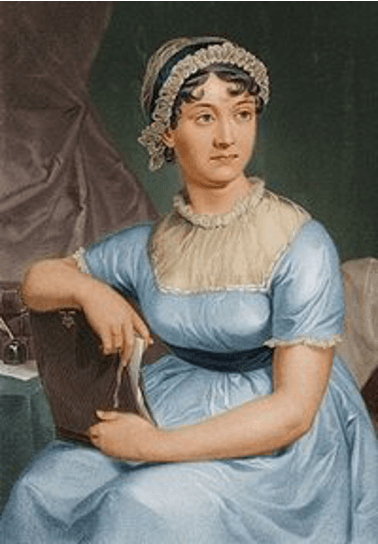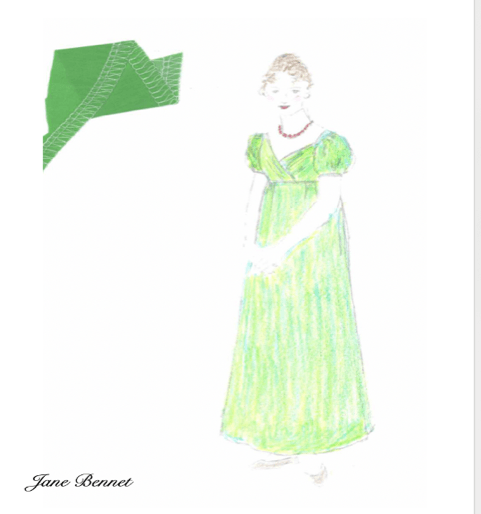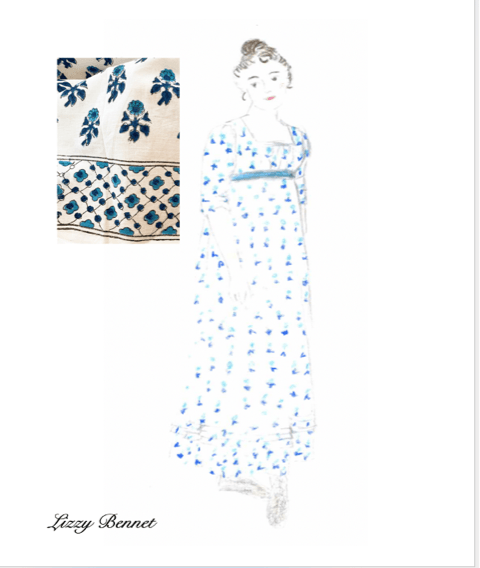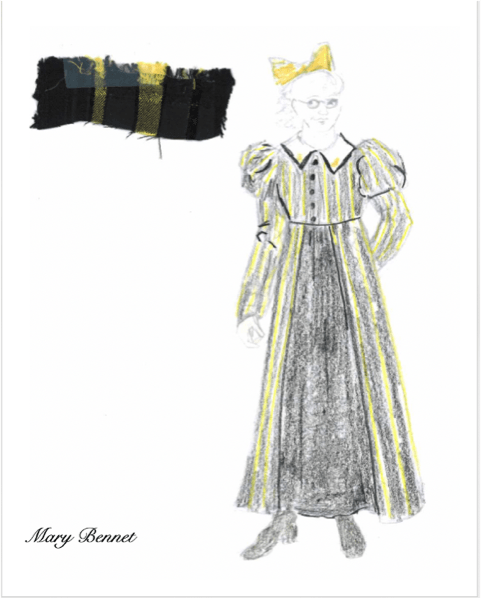Pride & Prejudice Digiturgy
Pride & Prejudice in History and Now
Lillie Kortrey
2021-2022 Dramaturgy Production Intern
About Our Great Authors: Jane Austen and Kate Hamill
Jane Austen began her formal schooling at age eight, learning the appropriate subjects for a young lady at the time. These included foreign languages, music, and dancing. When she had finished her formal education, Austen continued to learn, both from her father and brothers and through her own reading. Austen’s father fostered her hunger for knowledge by supplying her with his books and writing tools. She continued to read and eventually to write her own works. It was not until 1789 when Austen began to write seriously, generating what would become novels in the future. The first draft of Pride and Prejudice was completed in 1797 and the final version was released anonymously in 1813.
Kate Hamill is an actor and playwright. She is most well-known for adapting classic novels into plays, most notably Jane Austen’s Sense and Sensibility and Pride and Prejudice. Hamill’s Pride and Prejudice first premiered at the Hudson Valley Shakespeare Festival in 2017 at the Boscobel House and Gardens in Garrison, New York with Hamill herself playing Lizzy Bennet and her husband, Jason O’Connell, played Mr. Darcy.
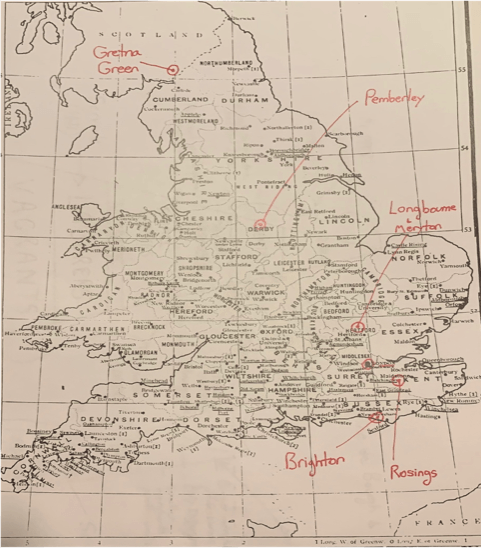
Above is a map of England and Wales before the Reform Act of 1832 provided by Professor William Abbott, Fairfield University’s resident British historian. The Reform Act of 1832 was parliamentary reform that provided equal distribution of seats and allowed for greater voter representation. Marked are the various settings and locations mentioned in Pride and Prejudice to help the company gain a better understanding of the vast distances and the characters were travelling by horse and carriage through the rough roads to visit each other; these journeys took a long time! The company of Pride and Prejudice is very grateful to Professor Abbott for providing this information.
Understanding Life in Jane Austen's England
Austen wrote Pride and Prejudice during the Regency era which lasted for nine (1811-1820), years when King George III took ill in 1811. He was declared unfit to rule, and his son King George IV became the Regent. The Regency Era was a time of social, political, economic, and cultural development in England. There was a strong emphasis on high society, elegance, etiquette, and extravagance. This time was filled with balls, new fashions, and romanticism. Pride and Prejudice is a product of Regency society within its themes of love, and criticism of a woman’s societal place.
Marriage in Regency Era England and the Rise of the Social Ball:
Arranged marriage was a common practice for centuries in England; however, in the Regency Era, the practice experienced a decline. Enlightenment (spanning from 1715-1789) ideas such as freedom, equality, and personal autonomy were introduced and heavily emphasized in society. This, in turn, resulted in the institution of marriage to come out of love and to be a choice between individuals, rather than an agreement. However, in the upper classes, arranged marriages lingered. Money, social status, and most importantly, property were factors that had to be considered in every match. Marrying for love was an inferior principle than marrying for socio economic stability. As Charlotte Lucas says, a woman would “have her whole life to fall in love”.
To meet a potential suitor, a formal introduction was required by a third party who was acquainted with the male and the female. There were several events where this type of introduction was possible including dinner parties, and festivals, but the most prevalent of these events was the social ball. At a private ball, everyone was assumed to be acquainted with one another and any man could dance with any woman. Additionally, young ladies in attendance at a private ball could not refuse a dance as they could at a public ball unless they did not intend on dancing for the rest of the night. A young woman showed her interest in dancing by pinning up the train of her gown.

The Dancing at Balls
The balls would often start with a dance where everyone, or most everyone would participate. This allowed for young people to scope out potential partners for the night. Dances throughout the night remained rather simple; however, more complicated weaves and intertwining movements were also common. Line dances involved multiple couples who would dance together. In simple line dances, the respective couples would perform the same steps. More complicated line dances saw different couples performing different steps.
Social Etiquette at the Ball and in Everyday Life:
A woman in Regency Era England was expected to be accomplished. This means that she was to engage frequently in a number of activities such as reading, riding, sewing, singing, playing piano, as well as speaking other languages. Women were expected to focus on being accomplished rather than pursuing education.
Ladies never crossed their legs; they would sit with their ankles crossed instead. Skirts never rose above the ankles.
When first meeting, after being introduced by a third party, bows and courtesies were always exchanged.
Gentlemen always bowed before leaving the presence of a lady.
At balls, men were expected to dance with any lady who was not already engaged in a dance, and a woman never rejected a dance from a gentleman. Dances were one of the few places where respectable men and women could talk privately, which made them a key proponent in finding a match.
Ladies never called on men alone - a chaperone was always needed.
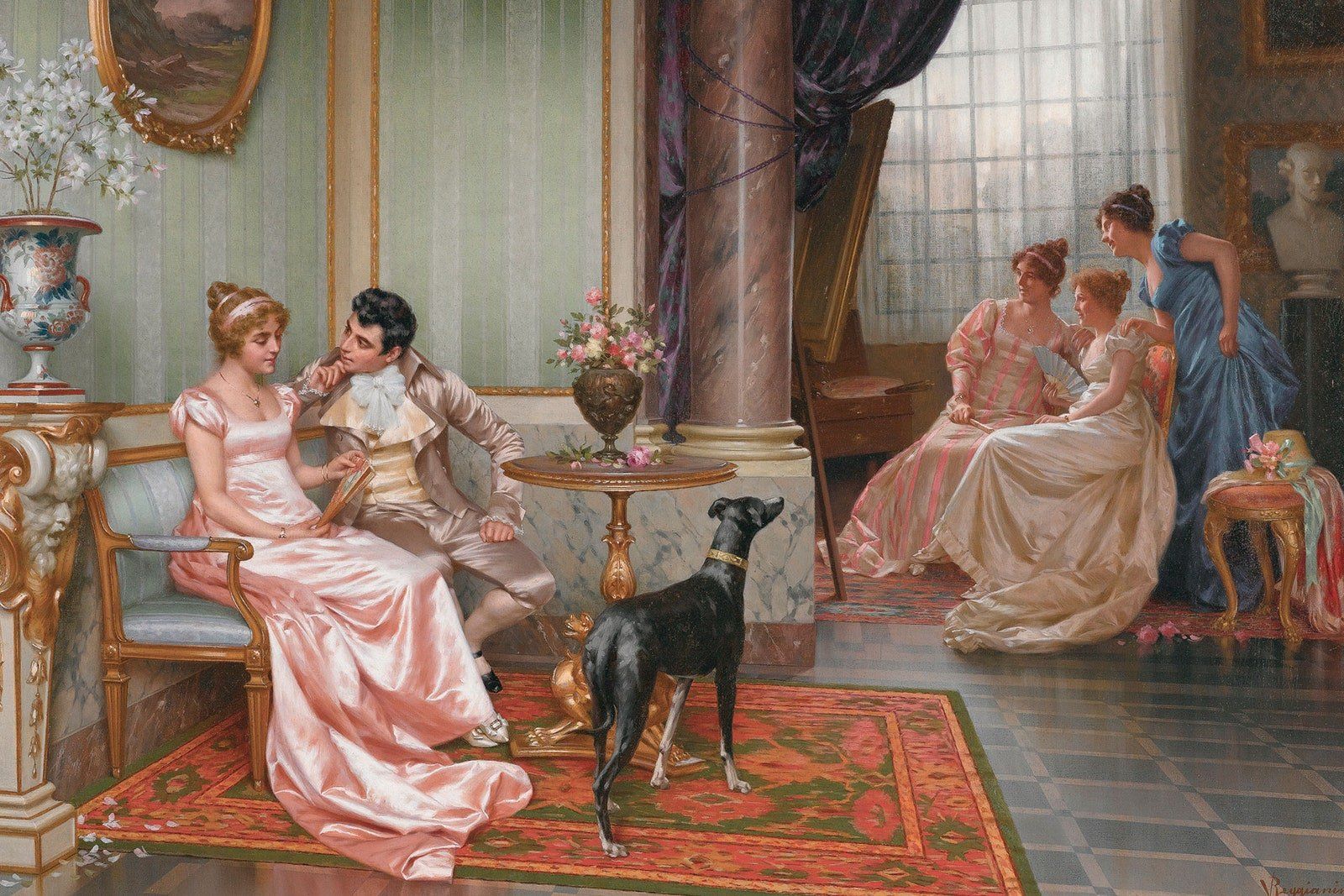
Courtship and Proposals:
When entering a courtship, the men acted as the leaders and the choosers, as the women waited to be pursued by a man. Men and women assumed these differing roles due to the fact that women needed a man for status and financial security, and not vice versa. The refusal of a man was the one active role women had in courtship.
Oldest children, both men and women experienced the most parental intrusion when it came to marriage. Until the age of 21, both men and women had to get permission from their parents if they wished to marry. Even though parental approval was not required after the age of 21, it was strongly desired. This was important for females especially, as they were viewed as willfully ignorant to find men of good character and considerable social and financial standing. Only the man had the ability to propose. He could either propose in person or through a letter. Either way the man opted; his intentions were known. Couples that were not yet engaged were never left alone unless in the case of a marriage proposal. Furthermore, a man did not directly write to a woman, unless the two were related. This is why Jane receives a letter from Miss Bingley about Mr. Bingley and Darcy’s whereabouts, instead of coming from Mr. Bingley himself. A proper proposal would see the man proclaiming his granted permission from the parents and listing credentials and ways in which he could support the woman. Women had the ability to reject an offer of marriage, although it was uncommon. Women, however, felt pressure to accept the first offer they received, out of fear that another man would not come their way, as they needed the social and financial security.
Unmarried Women and the Emergence of the Term “Spinsters”
The fear of becoming a spinster is present throughout Pride and Prejudice, seen especially through Mrs. Bennet, whose mission is to marry off all four of her daughters. Regency society put strong emphasis on marriage, especially for women, as both social and legal identity depended on the men in her life. The origin of the word “spinster” came from the mid 1300s. The term was used to refer to a woman who spun thread and yarn as a trade. In the Middle Ages, it was a common practice for one’s occupation to become their surname, and in legal documents women who spun yarn would have Spinster as their last name.
Spinster came to be a term for a single woman of a certain age, in the late Middle Ages. Some historians argue that married tradeswomen had greater access to the market and a better social standing because they were married. Married women did not have to work because they had a husband to provide for them, and therefore “spinster” became a patriarchal term for a working unmarried woman. Unmarried women assumed these jobs because they did not require complicated tools, they could be done at home. By the 17th century, the term “spinster” became commonplace and even was used in legal documents when describing an unmarried woman.
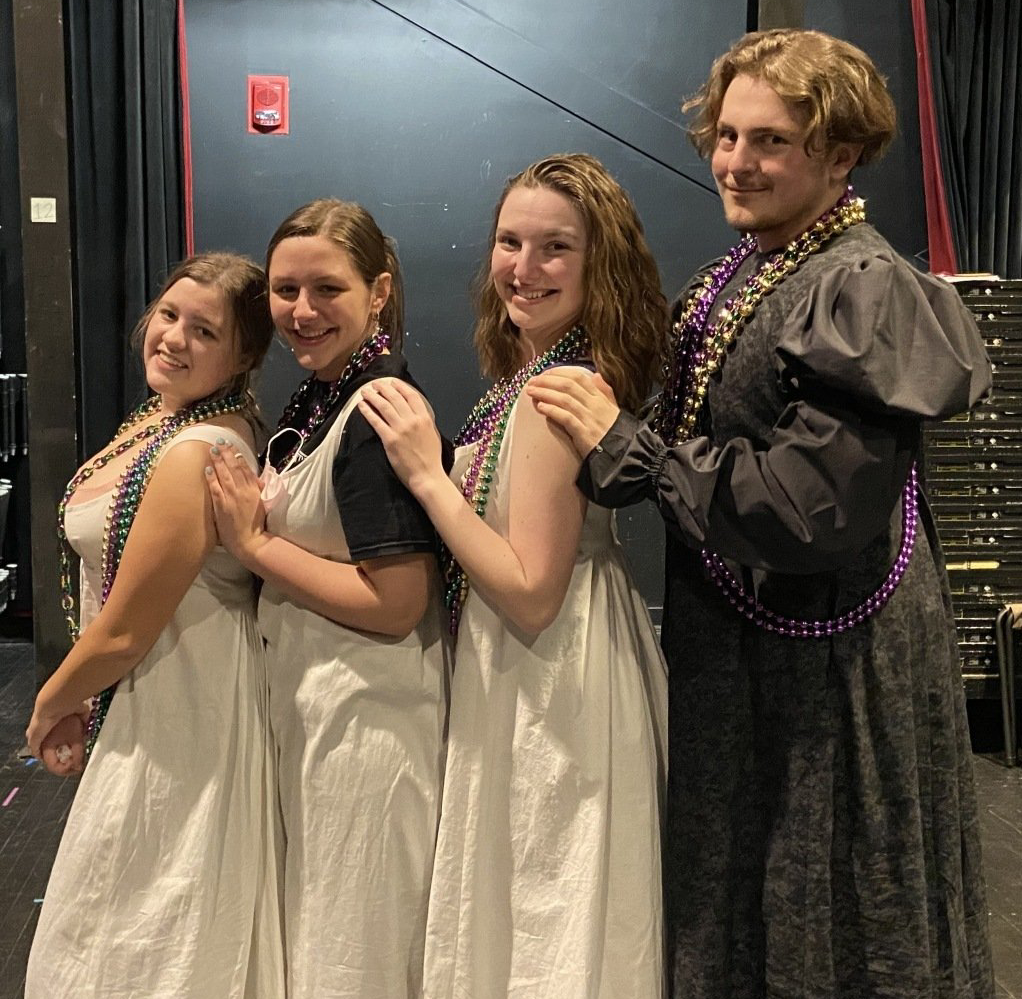
The Bennet Sisters (from left to right): Nora Jacobi (Lydia Bennet), Lillie Kortrey (Jane Bennet), Tracy Ferguson (Lizzy Bennet), Dima Alibali (Mary Bennet).
From left to right: Costume Renderings for Lydia Bennet, Jane Bennet, Lizzy Bennet, and Mary Bennet

Early Feminism, Roles of Women and Mary Wollstonecraft
Although it is unclear whether Austen read her works, the principles of early English feminist Mary Wollstonecraft are reflected through Elizabeth Bennet in Pride and Prejudice. As an Enlightenment thinker, Wollstonecraft believed very strongly in equality between the sexes, especially in regard to education and marriage. While girls were educated, their education was limited. They were taught instead to be accomplished and expected to marry. Wollstonecraft penned Vindication of the Rights of Women, which challenged the notion that a woman does not exist only to be an extension of a man. She argues for the equality of the sexes in the matters of education, work, politics, etc. This parallels Austen, as she wrote Lizzy Bennet to challenge the societal norms at the time. English law of the eighteenth century stated that a woman's legal existence was suspended by marriage. Married women were unable to sign bills or contracts, buy property, write a will, own her earnings, or have custody of her children. Women married for financial and social security, as they were unable to inherit property after the death of the patriarch of the family. Such is the conflict of Pride and Prejudice as Lizzy wrestles with social obstacles in relation to her place in society. Women could not inherit property, and therefore they had to marry for that security. Wollstonecraft challenged this truth, advocating that women had responsibilities beyond what they had been confined to in society: being a wife and mother, as society confined them to.
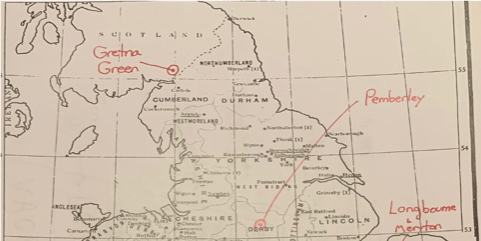
Gretna Green
Located in Scotland on the border of England, Gretna Green was a destination for runaway English couples looking to elope. In 1754, Lord Hardwick’s Marriage Act required parental consent to a marriage for couples in England under the age of twenty-one. The subsequent marriage was to be in the couple’s parish with an official clergyman presiding. Any clergyman found breaking this law served a fourteen-year sentence. This law was only enforced in England; the Scots did not change their marriage laws and customs. In Scotland, anyone over the age of fifteen was permitted to wed. Gretna Green’s proximity to the English border made it a popular location for young English couples to elope.
Who's Who:
Below is a character chart featuring all the characters in Pride and Prejudice, and their relationships with the other characters to help audiences follow along in the story. Note that some actors play multiple characters.


